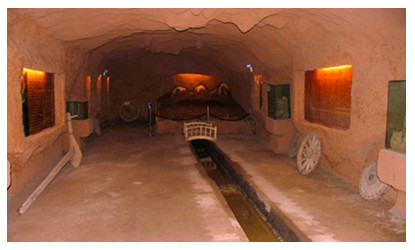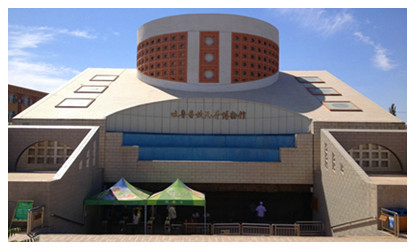Skype: neodalle-travel
Tel: +86 135 7447 2266
E-mail: sales@visitaroundchina.com
 draws the underground water to flow by itself to irrigate farmland. Karez systems are the crystallization of ancient people's diligence and intelligence. At its peak, this irrigation system exceeded 5,000 km and was also referred to as 'the underground Great Wall'. It is among the three ancient major irrigation projects with the other two being Ling Canal and Dujiangyan Irrigation Project.
draws the underground water to flow by itself to irrigate farmland. Karez systems are the crystallization of ancient people's diligence and intelligence. At its peak, this irrigation system exceeded 5,000 km and was also referred to as 'the underground Great Wall'. It is among the three ancient major irrigation projects with the other two being Ling Canal and Dujiangyan Irrigation Project.
History of Karez System
Karez systems are the life source of Turpan. In a sense, without them, there would be no Turpan culture. According to records, the history of the karez in Xinjiang dates back to 103B.C. Currently there are still over 400 systems.
Turpan has long been the center of a fertile oasis and an important trade center along the Northern Silk Road, at which time it was adjacent to the kingdoms of Korla and Karashahr to the southwest. The historical record of the karez extends back to the Han Dynasty. The Turfan Water Museum is a Protected Area of the People's Republic of China because of the importance of the Turpan karez water system to the history of the area.
Features of Karez System
A karez reduces evaporation, avoids getting polluted and needs no other power equipment; it runs from high to low ground owing to gravity alone. Turban is the hottest place in China and the arid climate makes water all the more precious. A karez system helps to ideally solve this problem.
Karez also functions as the natural air conditioner for the locals because they can sit in one while chatting or doing some chores. When exhausted during the scorching weather, sit in a karez, pick some grapes as they hang over the vertical wells and savour their taste, you will be thoroughly refreshed!
 It consists of four parts: vertical wells, underground channels, ground canals and small reservois.Generally, a karez is 3 km with the longest being 20 to 30 km with several dozen vertical wells. Sometimes the number of vertical wells exceeds 300. Until today, the shortest karez found is only 30 meters long. The vertical wells are for ventilation, digging and maintenance of the karez. The bottoms of all the vertical wells are connected so that water can pass through. The underground canal is about 2 meters high and covered with earth to resist the heat. The surface canals, connected to the underground ones, are not more than 1 meter wide with trees planted on both sides to prevent evaporation.
It consists of four parts: vertical wells, underground channels, ground canals and small reservois.Generally, a karez is 3 km with the longest being 20 to 30 km with several dozen vertical wells. Sometimes the number of vertical wells exceeds 300. Until today, the shortest karez found is only 30 meters long. The vertical wells are for ventilation, digging and maintenance of the karez. The bottoms of all the vertical wells are connected so that water can pass through. The underground canal is about 2 meters high and covered with earth to resist the heat. The surface canals, connected to the underground ones, are not more than 1 meter wide with trees planted on both sides to prevent evaporation.
Melting snow from the Tianshan Mountain is the water source of the karez. Water is collected by vertical wells and conducted by the underground canals to the oasis, where the water is held in the ground canals for irrigation. The vertical wells near the water source may be 100 meters deep while further downstream they are less than 10 meters deep.
Ample water was crucial to Turpan, so that the oasis city could service the many caravans on the Silk Route resting there near a route skirting the Taklamakan Desert. The caravans included merchant traders and missionaries with their armed escorts, animals including camels, sometimes numbering into the thousands, along with camel drivers, agents and other personnel, all of whom might stay for a week or more. The caravans needed pastures for their animals, resting facilities, trading bazaars for conducting business, and replenishment of food and water.
There are about 1,100 such wells in the area embracing Hami and the Turpan Depression. Today, the total length of such underground irrigation tunnels in Xinjiang runs for three thousand kilometers. The project can well be compared with the Great Wall and the Grand Canal. The world-famous grapes of Xinjiang own their excellence to the existence of these wells.
 Ask Questions ?
Ask Questions ?